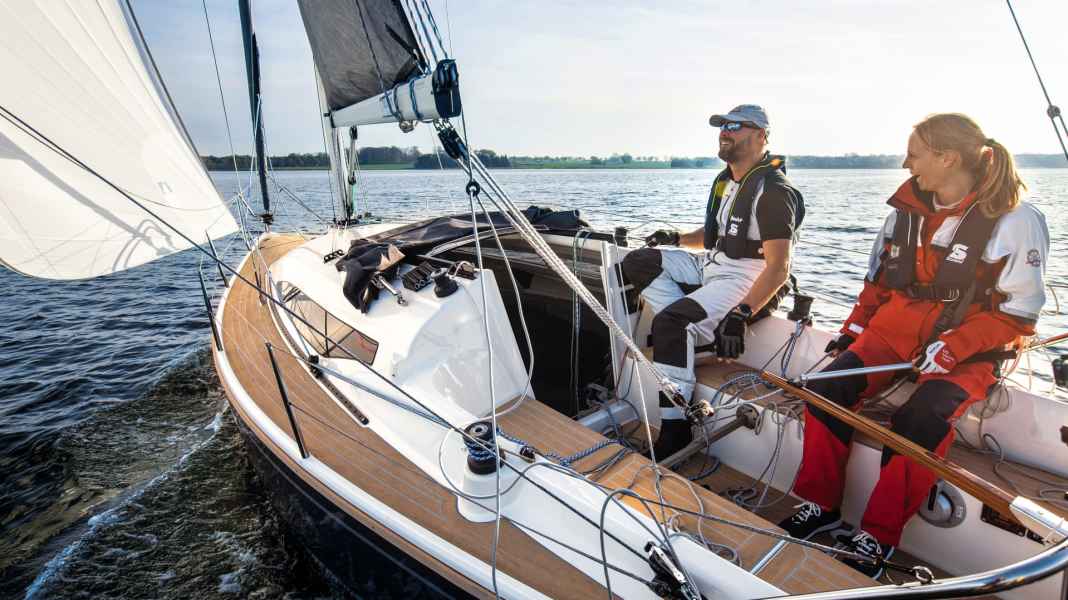
The days are getting longer, the temperatures are rising and things are getting busier in the winter storage sheds - unmistakable signs that the start of the season is approaching. To avoid any nasty surprises afterwards, there are many things to check and maintain when winterising your yacht. We have summarised the most important points in detailed articles with explanatory videos.
An overview of the topics:
Comfort and safety on the water depend on careful preparation. Small omissions can cause major problems. If, for example, one of the hose clamps securing the cooling water pipe to the sea valve is loose, this part, which costs less than 3 euros, can make the difference between a good season and an accident. Forgetting to check the anode of the bow thruster would not be quite so tragic. It won't sink the boat, but it will still incur unnecessary costs in case of doubt.

This can be confirmed above all by the insurers, to whom the invoice for damage is usually submitted in the end. We spoke to Dirk Ammann about the most common mistakes and omissions during winter storage. Dirk Ammann is Sales and Underwriting Coordinator at Pantaenius, Europe's leading provider of yacht insurance, and has gained a lot of experience in his 20 years of professional life. Some of you will certainly have seen him with the Pantaenius safety rib at classic regattas.
If it can fall onto the deck from above or penetrate the ship from below, then I at least seek professional advice."
YACHT: Mr Ammann, why do you think the start of the season is so important?
Dirk Ammann: Quite simply, preparation is the best way to start a trip safely and get through the season without damage. Of course, not everything that can happen on the water can be avoided with regular checks and the right tools. However, at least 15 per cent of the damage registered by us, or a total of around 1,000 per year, can be attributed to a lack of care and maintenance. The number of unreported cases is probably somewhat higher. As a rule, it is not a lack of willpower, but perhaps rather a lack of time management. We therefore consider it extremely important to plan and prepare the start of the season properly.
Which damages are among those that Pantaenius attributes to maintenance and servicing deficiencies?
Firstly, these are almost all mast breakages and other damage to the rig. The trend of no longer laying the mast in winter, whether for reasons of comfort or cost, unfortunately contributes to the fact that thorough checks and visual inspections can only be carried out irregularly or not at all. In addition, water ingress due to dilapidated water-bearing fittings or onboard outlets, fire and scorch damage in the electrical and cabling area and, in particular, engine damage caused by contamination, corrosion or other factors.
Does the trend mean that these problems did not exist in the past?
The problem is probably older than Pantaenius, but we realise that maintenance backlogs and the resulting problems are increasing. Today, boats are increasingly becoming a means to an end and are no longer necessarily the centre of their owners' lives. That probably sounds like a romanticisation of the good old days, but it's not necessarily meant that way. In the past, winter work on the boat was simply more natural and the boats were naturally somewhat smaller and technically less complex. In 2000, a boat insured with us worth around 60,000 euros was on average just over eight metres long. Twenty years later, we are well over nine metres. Inflation factored in. Not to mention the increased complexity of wiring harnesses and electronics. The general ageing process of the GRP fleet naturally also contributes to this effect and ensures that there are now more old boats for relatively less money, but I think the trend is becoming clear.
What can the owner still manage well today and what would he rather leave in the hands of a specialised company?
It's hard for us to give a generalised answer to this question and it has a lot to do with personal skill and the type of boat. After all, there is no single winter check, and what's more, there is hardly any shipyard that can check, assess and maintain all the relevant systems as a single specialised company. There are many different trades that come into play. In my experience, it is best to document all service intervals in the logbook in as much detail as possible. If you are unsure, you can easily obtain the necessary information on the Internet or with personal advice at the next trade fair. Even if a specialised company is commissioned, it cannot be assumed across the board that they know all the key data exactly, and even the manufacturers will not automatically remind owners to comply with the corresponding intervals, as is perhaps the case with new cars.
What should owners avoid from a boat insurance perspective?
Hands off when it comes to live cables and electrical installations. Improper wiring, corroded plug connections and the like are one of the most common causes of fires on board and total losses. Only very few people are likely to have the knowledge and skills required to carry out such work safely, either professionally or due to personal talent. Otherwise, the rule of thumb for me is: if it can fall onto the deck from above or penetrate the ship from below, then I at least seek professional advice. This means that when it comes to rigging, sea valves, rudder cokers etc., a personal inspection is often perfectly feasible, but only if you have learnt from an experienced practitioner what you are actually looking for.
You mentioned the topic of time management at the beginning. What do you need to pay particular attention to?
If you want to place orders, you should do so towards the end of the season. In other words, when the ship is still in the water. Service providers can then schedule the work well and you have the opportunity to react to any problems you discover. What's more, sometimes it's the little things that make a difference in the end, and you can usually see them best when you're still sailing the boat. How do the parts actually behave under load? Placing orders in spring, on the other hand, is usually difficult. Owners should limit themselves to safety-related aspects rather than cosmetic corrections, as most specialised companies are already booked up.
What advice can be given to inexperienced owners to avoid the time trap?
It helps to keep track of all the things you have noticed during the season. Where is it dripping, where is there a stiff part and where is there suddenly too much play? It is hardly advisable to postpone all checks and maintenance work until the off-season anyway. Anyone who takes longer trips should logically also carry out regular functional and visual checks during the season. Routine prevents nasty surprises. Motorcyclists, hobby pilots and even cyclists know the principle. If you also have a supplementary checklist with the most important points for the installed systems, you are optimally equipped for efficient work in winter storage.
If something important has been forgotten or there simply wasn't enough time, but the harbour operator is urging you to clear the space: don't be put off. There is often the possibility of delaying the craning a little longer, for example in open storage or on alternative sites, for a small fee, without holding up the entire operation.
In the event of a claim, does the insurance company check whether and when maintenance work was carried out?
No, the insurance company does not initially check which service intervals have been adhered to. The only exceptions are extensions to our cover, for example for engine and machine systems. As the benefits here go far beyond the usual manufacturer's warranty, it is mandatory for us to adhere to the maintenance intervals specified by the engine manufacturer. However, nobody has to take out this additional module. In addition, the insurance company will of course check what caused the damage. However, owners with a good insurance provider should not be fooled by this. High-quality policies exclude the defective part itself, but cover the consequential damage. A shroud that I have neglected for years will therefore not be reimbursed. But I do get compensation for the resulting damage to the stationary goods.
What is the situation when taking out insurance?
As a rule, a close look is taken here when it comes to the rigging, and a professional rig check or replacement of the standing rigging is required for old or very old ships. Insurance is designed to protect against the unexpected. However, our statistics show that major rig damage becomes more and more likely with increasing age. At a certain point, it is no longer a question of if something will happen, but when. Almost all manufacturers confirm our observations in this respect. Even if, as always, there are exceptions and the actual degree of wear and tear or material fatigue can be very individual. Depending on where the boat is moored, how it is used and whether the mast is laid down in winter or the boat remains rigged. Once a boat is covered, good insurance providers, as already mentioned, generally do not impose any requirements for maintenance or replacement of the standing property. However, this should not be overstretched in your own interest. In the end, mast wins against head.
Do you have any final words, any good advice for sailors at the start of the season?
Damage does not remain without damage. We don't say this because we like the role of the critic, but because we have been dealing with the smaller and larger problems of yacht owners every day for over 50 years. Even if most of the damage is insured, the annoyance for those affected is still great. When things go wrong, they happen at the most unfavourable time and in the most unfavourable place. Especially these days, the supply of spare parts or free spaces in repair shops cannot always be taken for granted. Not to mention new boats. At the end of the day, however, I am also entrusting my life to the boat and should treat it with appropriate reverence. With the right planning, I have more time for the essentials, which for me are first and foremost the fun of sailing and long days on the water.
Interview: Lars Bolle

